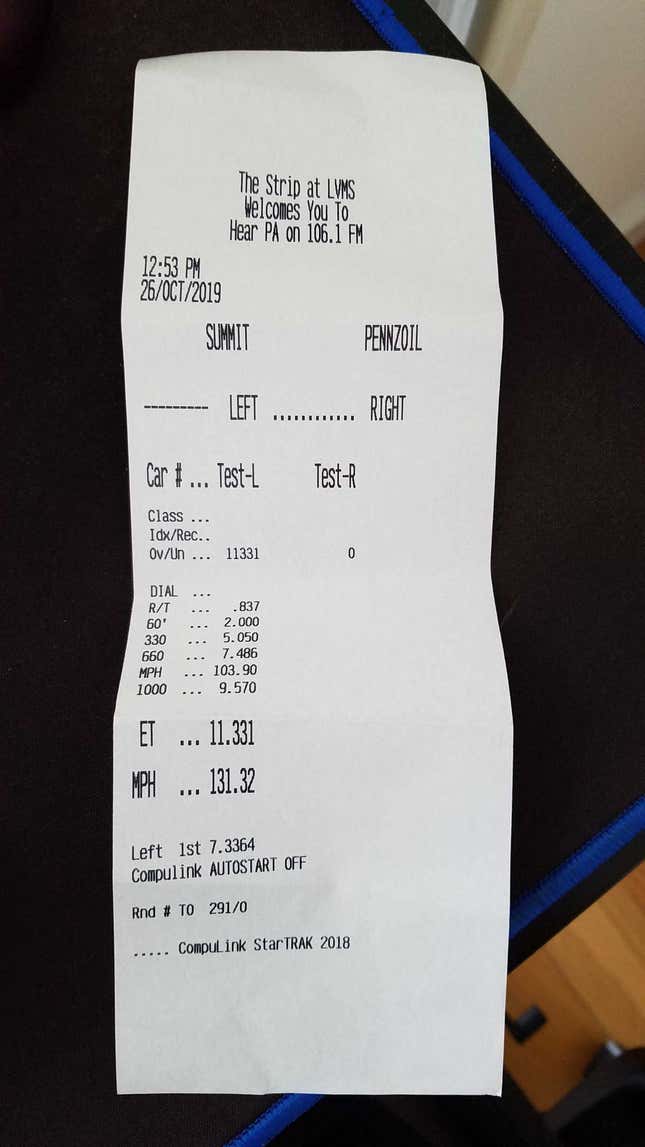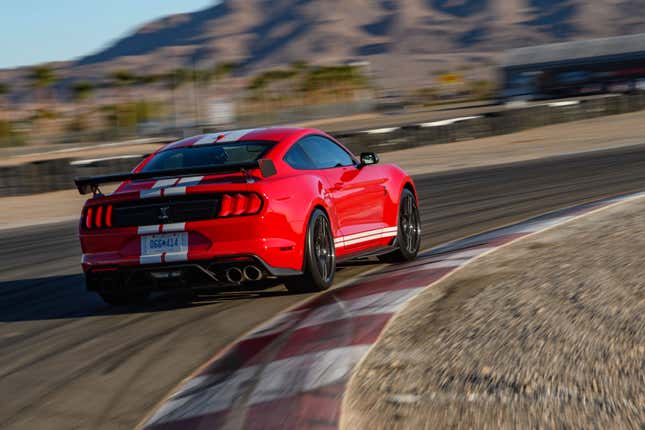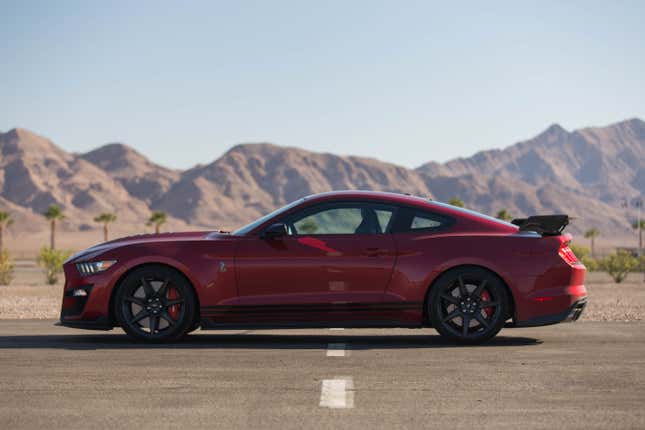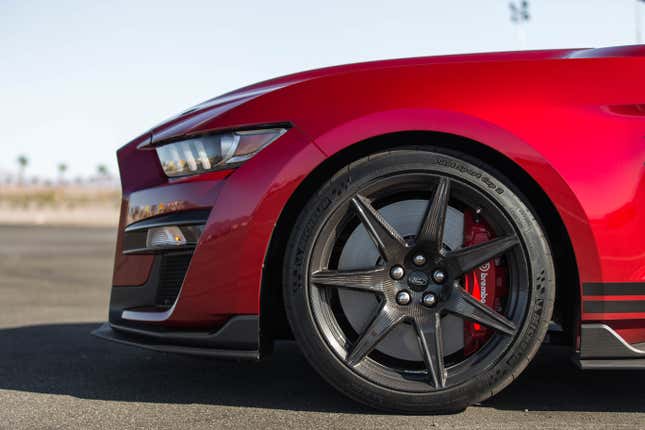This 2020 Ford Mustang Shelby GT500 is it. The Big One. The most powerful, street-legal car Ford has ever built. We’ve poked and prodded it from top to bottom. Now all that’s left to do is drive it.
There’s power, of course. There’s noise, certainly. But there’s also handling, comfort and daily drivability. Yes, really. Gone are the days of a Mustang with a fat engine being merely a one-trick pony (sorry).
(Full Disclosure: Ford flew Jalopnik senior video producer Adam Milt and me out to Vegas to drive the GT500. It put us up in a nice hotel, paid for all our food and booze and rented out the Las Vegas Motor Speedway for us to use.)
I will be frank with you. I was slightly nervous to go drive a car with 760 horsepower. One nightmarish, imagined situation of peeling out and hitting a curb after another chased themselves through my mind. But nothing of the sort happened. The car has chill. You just have to make sure you do, too.
What Is It?

The Shelby GT500 is the latest big-nasty Mustang Ford has made. The last one we saw was from 2013 to 2014. That car had a 5.8-liter, supercharged V8 and claimed 662 HP. This one has nearly 100 more horsepower from a smaller engine.
But at its core, it’s still a Mustang. The seats are comfortable. There are back seats, too, if you want them. The trunk is decent. The air conditioning is great. The interior layout and plastics are all very familiar.
This is all to evidence how daily drivable the GT500 is. You just happen to have a huge, powerful engine sitting in front of your knees.
Specs That Matter
As you already know, the GT500 promises 760 HP. Torque comes to 625 lb-ft. All of that’s from a 5.2-liter, cross-plane crank V8 with a 2.65-liter, Roots-type, inverted supercharger with an air-to-liquid intercooler. And for a supercharged unit, the 7,500-RPM redline is delightfully high. The power gets sent straight to the rear wheels via a seven-speed Tremec dual-clutch transmission.

Here are some of Ford’s claimed performance figures: Top speed of 180 mph. Zero to 60 mph in 3.3 seconds. A quarter-mile in 10.7 seconds. Zero to 100 mph and back down to zero in 10.6 seconds.
So, if we are to take Ford’s figures at face value, this is a Mustang that weighs 4,183 pounds, can put down times that would give many supercars a run for their money and make Domenic Toretto proud. If that’s not a democratization of speed, then I don’t know what is.
What’s Great
Ford’s driving program put us on a highway with the GT500 for roughly 45 minutes. Cruising between 65 and 70 mph, the engine hummed along placidly below 2,000 RPM and, save for the noise made by the Michelin Pilot Sport Cup 2 tires, it was pretty quiet in the cabin.
The car is perfectly happy to settle down into tame commuting and is geared in such a way that it never feels bored with you for keeping the speeds low.
On the flip side, though, you do need to exercise some caution with that gas pedal. As great as the car is at tolerating going slow, we both know in our hearts that’s not what it’s for. Merely breathing on the throttle is poking a dragon. Seven-hundred and sixty HP is no joke and should absolutely not be treated as such. Do yourself a favor if you drive this car and exercise some responsibility and restraint.
Depending on which mode you have it in when you lean on the accelerator, the transmission clicks down a few gears almost instantly, noise enough to reduce a lion to a mewling kitten roars from the tailpipes and you’d better pray there’s room in front of you.
Thankfully, Ford provided us with a quarter-mile drag strip to use.

In Drag Mode, you can left foot-brake and floor the gas, which activates the car’s launch control. The acceleration is brutal, forceful and relentless, thanks to the dual-clutch shifts. I found myself glued to my seat as if I were in a jet taking off. Preposterous stuff.
It’s funny. The GT500 has more power than the McLaren 720S, but the McLaren feels a lot faster. The acceleration comes with a lot less drama. That’s because the McLaren is nearly 1,000 pounds lighter, but lacks the noise.
My personal best quarter-mile time came to 11.331 seconds at 131.32 mph. (Later on, the Ford reps would say we had the conditions working against us since elevation was about 2,000 feet.) Four runs later, the car hardly felt too hot or worn out. It could probably launch itself like this all day.
Out on the track, the GT500 has a very hammer-ish way of handling itself. The brake calipers clamp down on the huge, 16-plus-inch front rotors and drag the heavy body down to cornering speeds.
On the straights, the power is addictive and so is the noise; a furious, screaming orchestral symphony of a revving V8 keeps pace with you, keeps your heart rate high.
And the days of a Mustang being unable to handle a corner are far, far departed. Those Pilot Sport Cup 2s sink their claws into the pavement and help rip the GT500 around while you’re in the driver’s seat, getting an excellent core workout while fighting to stay upright.

I did my laps, was very impressed by the way the car handled, but still refused to give myself wholly over to it. The poetry of hosting the GT500 media launch in Las Vegas—a sheer, no-holds-barred, debauchery-land of excess—was not lost on me. The car was intimidating and I wasn’t fool enough to gamble with my talent when the dealer clearly had the upper hand.
So, I strapped myself into the passenger seat to see how Ford Performance Vehicle Dynamics Engineer Steve Thompson would fare.
Under Thompson’s control, the GT500 was nothing short of superlative. The grip through the corners was something you could hinge the very planet on. You’re working with big power here, so the braking and the grip needs to be big, too. LVMS is a long, technical course, so there were plenty of sweeping turns, a chicane and a decreasing radius turn for the car to flex its handling prowess.
The ride-along was one closer to a roller coaster than I’ve ever experienced in a car in my life. Thompson kept the car balanced right on the knife-edge of grip, barreling us through turbulence in the corners, the tires screeching in harmony with the shriek of the engine. Hitting the apexes through the chicane came with three violent BAM-BAM-BAM bumps that rattled my teeth in my head. I think we caught air. I got out of the car a changed person.
There’s video of this. Keep an eye out for it.
What’s Weak

There’s no getting around the fact the GT500 is and feels like a big car. The EcoBoost High Performance Pack Mustang remedied the issue somewhat by having fewer cylinders and thus having a lighter nose. Here, with eight cylinders and a beefy supercharger sitting over the front axle, the weight is noticeable when you drive and turn.
That overall sensation is also amplified when you’re looking out the front windshield because the huge hood scoop does block visibility somewhat. Plus, all that power means you’re not doing so great on gas mileage. The EPA estimates the GT500’s city mileage to be a hilarious 12 mpg, 18 mpg on the highway and 14 mpg city and highway combined.
You can also forget all about blending in when you have one of these. Even if you took all the stripes off and painted it the most boring shade of silver ever (why would anyone do that), the gaping front fascia and rear wing all but scream to the world this is something to pay attention to. The exhaust has a quiet mode, but that’s got to be there for the placebo effect more than anything else. The 2020 GT500 will be a “quiet car” the same day everyone stops raving about In-N-Out.

Last bone to pick with the car: no manual. I’ve driven a 2013 Shelby GT500 and it was a joy. The short-throw, cue ball shifter felt great in the hand and the engine produced so much low-end power you barely needed to give it any gas to get moving.
Let me be clear, the Tremec dual-clutch is great. It’s fast and efficient and makes for setting incredible quarter-mile times. But it’s also one more thing separating me from what is an overwhelmingly visceral engine—one that’s miraculously being produced in the year of our Lord 2019, when nearly everyone else is downsizing, turbocharging or hybridizing.
I’d almost have the manual over the blistering zero to 60 times.
Early Verdict
I got a lot of you asking if the GT500 is worth it over the Shelby GT350. Having now driven both, I’m not so sure the two are comparable, other than the fact they are both Mustangs.

The GT350, with its flat-plane V8, six-speed manual and aerodynamic and suspension wizardry, is more akin to the track scalpel. This is the analog sports car, with a high-revving engine that won’t outrun its chassis unless you really tried.
The GT500 is the hammer. It’ll do the precision track stuff just fine, but it’s not as confidence-inspiring. Its limits are so much more exaggerated, so much loftier; as a result, the balance is far more precarious. With practice, I’m sure I’d get the hang of the GT500, but mostly I loved using it on the drag strip. That acceleration will never get old. Choosing between the two will come down to your wallet and what you want your driving experience to be.
My time with the GT500 wasn’t long, but just enough for it to stand out as a ferocious, loud and tire-smoking memory in my mind.
What a thing.

Update 9:48 a.m. EST: A Ford spokesperson reached out with the official curb weight. This story has been updated to reflect it.
